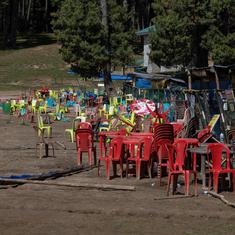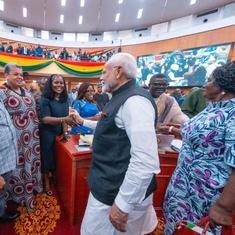Prime Minister Narendra Modi in his recent Independence Day speech warned of a “population explosion” in the country and called for schemes to address the challenge. The prime minister claimed India’s population growth is a hindrance to development and he lauded small family norm as an “act of patriotism.”
This was the first time in several decades that a prime minister had mentioned population control in a public speech. Speculation is rife that the Central government aims to propose a national population control law.
But is it true that the country faces a “population explosion” as Modi claimed?
Census data shows that the population growth rate nationwide has declined in every census since 1981. While the country’s population increased by 21.5% between 1991 and 2001, the rate of population growth slowed to an increase of 17.7% between 2001 to 2011. According to the Ministry of Finance in its recent Economic Survey 2018-’19, the country’s population is expected to grow by only 12.1% between 2021 and 2041.
Annual growth rate
According to the most recent population projections from the United Nations Population Division, India’s annual population growth rate currently sits at about 1% per year. This places India’s annual growth rate below population growth rates in Iran, Chile, Australia, and Ireland – countries that most would be hard-pressed to claim are facing unchecked population growth.
The primary factor driving the decline in the population growth rate has been falling fertility. The total fertility rate in India – the estimated number of children per woman over the reproductive lifespan – has fallen considerably over the past several decades. In 1971, women in India had about 5.2 children on average, according to Sample Registration System data from the Office of the Registrar General. But by 2017, the total fertility rate in India had fallen to only 2.2 children per woman.

Fertility in India has fallen so much in fact that the country may already be below the replacement rate – the minimum fertility level needed for the current generation to replace itself. While 2.1 is typically the rate cited in the media as the minimum level needed to achieve replacement fertility, the replacement fertility rate actually varies depending on the level of infant and child mortality in a given country.
Imbalances in the sex ratio can also force up the replacement rate as more births overall are needed where there are disproportionally fewer female births.
In India, replacement fertility is higher than 2.1 due to imbalances in the sex ratio and the practice of sex selection and female foeticide. According to the Ministry of Finance, the actual replacement fertility rate in India currently lies somewhere between 2.15 and 2.2.
Fertility rate projections
The Ministry of Finance projects the all-India fertility rate will fall to 1.8 by 2021. If accurate, this could mean that the total fertility rate nationwide currently sits at about 2.0, which is below the replacement rate. Demographic projections from the United Nations are only slightly more optimistic, pegging total fertility in India in 2019 at 2.2 –
at rate which, according to the Ministry of Finance, could still be at replacement fertility.
In urban areas, fertility is certainly already below the replacement rate. Sample Registration System data shows that the urban fertility rate in 2017 was 1.7, a rate similar to fertility rates seen in China and in low-fertility countries in Europe such as Belgium, Denmark, and Norway.
But India’s’s rural areas are not far behind either. In 2006, fertility in rural areas had stood at 3.1. By 2017 that rate has fallen to 2.4. This means that fertility in rural areas has fallen by 22.5% in a period spanning just a little over a decade.
Fertility is also already below replacement in many states, particularly in the south and north west. In fact, fertility is already below the replacement rate in 13 out of 22 major states and Union Territories.
UP and Bihar
Even in India’s highest fertility states, the number of children per woman has declined considerably over the past few decades. While the fertility rate in 2006 stood at 4.2 in both Bihar and Uttar Pradesh, by 2017, fertility had fallen to 3.2 children per woman in Bihar and to 3 in Uttar Pradesh. Even the Indian state with the highest fertility – Bihar—is not especially high by international standards. Fertility in western Africa stands at about 5.08, according to the United Nations. In Gabon, a central African country with a GDP per capita higher than India’s, according to the World Bank, the fertility rate currently stands at about 3.9.
Similarly, fertility has also fallen among Scheduled Castes and Schedules Tribes. Total fertility in 1992-’93 was 3.92 for Scheduled Castes and 3.55 for Scheduled Tribes, according to the National Family Healty Survey. By 2015-2016, however, fertility had fallen to 2.26 for Scheduled Castes and and 2.48 for Scheduled Tribes.

Sangh Parivar’s concerns
The Sangh Parivar has long raised alarm by an alleged “demographic imbalance” as a result of slower population growth among India’s Hindu population compared to the Muslim population. Rajya Sabha MP Rakesh Sinha, who introduced a population control bill in Parliament in July, has lamented the decline in the percentage share of Hindu population in India since Independence and has said that legislation on population regulation is needed to maintain “religious balance”.
But fertility rates among Muslims in India has fallen faster than among Hindus. According to the National Family Health Survey, fertility among Muslims in the country has fallen by 1.79 children per woman since the early 1990s. It dropped from 4.41 in 1992-’93 to 2.62 in 2015-’16. In comparison, fertility among Hindus fell by only 1.17 children per woman over the same period.
Far from facing a “population explosion” as Prime Minister Modi has claimed, demographic data shows that population growth in India is slowing across all major demographic groups as well as across all states and Union Territory. According to the United Nations, India’s population is set to peak at 1.65 billion in 2059 and begin declining thereafter.
Recent experience
And while a population tally of 1.65 billion may sound daunting, it is helpful to keep in mind that the country’s population today at nearly 1.37 billion is more than double what it was in 1980. India has also already dealt well with large population increases in the recent past. Since 1990, the national population has increased by 493 million people. Yet since 1990, per capita GDP has more than tripled, according to World Bank data. The prevalence of hunger among the country’s poor has also declined. According to the United Nations Food and Agricultural Organisation, the percentage of people undernourished fell from a three-year average of 23.7% of the population in 1990-’92 down to 14.5% in 2016-’18.
The population control policies advocated by some politicians today seeking to limit families to no more than two children each are unnecessary. Fertility has fallen considerably in recent decades even without a national population control law being in place.
Additionally, enforcing two-child policy restrictions risks causing significant demographic problems for India down the road.
For one, two-child policies risk worsening the sex ratio imbalance and the practice of female foeticide. A study by S Anukriti at Boston College and Abhishek Chakravarty at University of Essex found that state two-child policies have had a significant effect in increasing the likelihood that upper-caste women would give birth to a boy at second birth if their first child had been a girl.
Missing girls
In a recent report released by our organisation, I found that approximately 15.8 million girls have gone missing at birth in India since 1990 as a result of sex selection. Imposing a national two-child policy would only exacerbate the problem.
Imposing a nationwide two-child policy may also increase the number of abortions as women who find themselves pregnant with a third child may seek a termination regardless of the child’s sex in order to avoid penalties or a loss of government benefits for exceeding their birth quota.

Adopting policies to control population growth could also risk prematurely accelerating India’s transition to an aging population. China, as a consequence of its one-child policy, is now grappling with how to deal with a large aging population. In China today, there are a roughly five working-age adults for every elderly person over the age of 65, according to United Nations population data. But by 2050, there will be only about two working-age adults per elderly person in China. Population aging threatens to hamper China’s economic growth in the decades ahead, a path India would be remiss to follow.
Additionally, policies which penalise families for having more than two children would fall disproportionately hard on the poor and on minorities and could constitute a violation of human rights. The Proclamation of Teheran, a declaration agreed to by 84 nation-states (including India) at the 1968 International Conference on Human Rights, established an international consensus that “parents have a basic human right to determine freely and responsibly the number and spacing of their children”. This commitment was later reaffirmed by India and 178 other nations at the International Conference on Population and Development in Cairo.
Preventing Emergency-era excesses
Respect for the basic right of couples to freely decide the number of children they have is essential as it is the safeguard that prevents abuses such as those seen during the Emergency under Indira Gandhi when over 8 million men were forcibly sterilised.
India does not need a two-child policy. Men and women with higher levels of socioeconomic development tend to have smaller families without any incentives to do so. According to the National Family Health Survey, women with 10-11 years of education have a total fertility rate of 1.99, as compared to women with no education who have 3.07 children on average.
The Centre should focus on improving education and development among the poor and move away from seeking penalise those who exercise their basic right to decide the number of their children.
Jonathan Abbamonte is a Research Analyst at the Population Research Institute.










